It took years for Jaguar management to approve the marque’s first station wagon. But these days, few brands have been more willing to challenge tradition – and its clearly paying off, the F-Pace SUV becoming almost overnight Jag’s best-selling model.
Soon, there’ll be three utes in the line-up, but the one that might give traditionalists the biggest shock made its debut in Graz, Austria today. And it’s not just Jaguar fans who are in for some surprises. The new I-Pace is not only the brand’s first all-electric offering but it boasts a radically different design language, inside and out, meant to take maximum advantage of its battery drivetrain.
With the batteries, motors and most other key components moved from the engine compartment to underneath the load floor, the Jaguar I-Pace delivers a positively massive cabin inside an otherwise compact footprint. It’s the sort of dramatic transformation that is likely to sweep through the auto industry as more and more manufacturers electrify their products.
“We set out with a clean sheet approach to harness new battery electric technology with an architecture engineered from the outset to optimize EV performance, aerodynamics and interior space. The result is the I-Pace – a true Jaguar and a truly driver-focused EV,” said Ian Hoban, Jaguar’s Vehicle Line Director.
(Jaguar launching I-Pace racing series. Click Here for the story.)
Based on the Jaguar C-X75 concept vehicle and the subsequent I-Pace prototype unveiled 16 months ago, the I-Pace is likely to challenge assumptions in a variety of ways, especially for those who still think electric means slow and stodgy. Twin electric motors, one for each axle, deliver a combined 394 horsepower and 512 pound-feet of torque, enough to launch the electric ute from 0 to 60 in 4.5 seconds. While not quite as quick as a Tesla Model X with optional Ludicrous Mode, that time makes I-Pace one of the fastest utes in its segment, whatever its power source.
Those twin motors provide what can be called a through-the-road all-wheel-drive system, with no driveshaft tunnel intruding into the passenger compartment.
The driveline is powered by a 90 kilowatt-hour lithium-ion battery pack that is expected to deliver about 240 miles range using the EPA test cycle, though final numbers haven’t been released yet. Using a standard, 240-volt Level 2 charger, recharging will take less than 10 hours, while a motorist will be able to get an 80% top-off in just 40 minutes plugging into one of the new Level 3 fast chargers popping up across the country. The batteries, incidentally, will carry an 8-year/100,000-mile warranty.
The regenerative braking system, which is meant to recapture energy normally lost during braking and coasting, can also be set to allow one-foot driving. Think of it as the engine braking one gets with the transmission set in a low gear.
Comparisons to Tesla will be inevitable, and the Jaguar I-Pace will join its California rival in tapping into what is expected to be a fast-growing market for electric vehicles around the world. There’s likely to be particularly strong growth in the e-SUV segment, matching the broader shift from conventional passenger cars to SUVs and other light trucks.
Tesla already has the Model X, which typically rolls out of U.S. showrooms at more than $100,000. Pricing for the I-Pace won’t be announced until March 6 when the Jaguar electric ute makes its formal debut at the Geneva Motor Show, but insiders have told TheDetroitBureau.com it will come in substantially below the Tesla offering.
One challenge for Jaguar will be ensuring quality. If it can deliver in that category it could get a leg up on its rival, the Model X recently rated the worst vehicle tested by Consumer Reports magazine in terms of reliability.
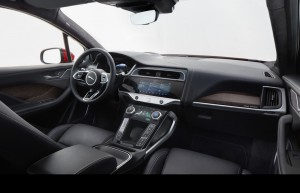
With the elimination of many of the mechanicals needed for a gas-powered vehicle, the new I-Pace offers plenty interior space.
(Click Here for details about the debut of Jaguar’s E-Pace SUV.)
Like the Model X, the 2019 Jaguar I-Pace will be capable of receiving over-the-air updates for its software systems. Much as with the latest smartphones, that will allow the automaker not only to make on-the-fly updates but add new features to its new InControl Touch Pro Duo infotainment system. Here, Jaguar actually borrows an idea we first saw on some Acura models, with a 10-inch touchscreen atop the center stack, and a 5.5-inch touchscreen below that. This will allow for a variety of different functions to be displayed simultaneously, such as navigation and audio.
That new navi system not only plots one’s route from Point A to B but factors in things like road topography and even a motorist’s driving style to determine the most efficient way to get to a destination.
The I-Pace will even work with Amazon’s Alexa voice assistant, with a “skill” allowing an owner to ask for vehicle information remotely using any Alexa-enabled device. While you won’t be able to order a pizza or open your garage door remotely using Alexa from inside the car, at least not initially, the over-the-air, or OTA, software could conceivably add such features in the future.
Why go with a battery SUV? The immediate answer might be that this is where the broader automotive market is turning, utility vehicles of all sorts accounting for more than half of the U.S. market in recent months, as well as a growing share in other key markets, such as China and Europe.
And, since they generally get lower mileage, utes also pose a challenge as manufacturers struggle to meet increasingly stringent emissions and fuel economy standards – never mind new rules, like those recently enacted in China – that specifically demand a shift to zero-emissions technology.
Another key reason is that utes generally have more places in which to tuck batteries than comparably sized sedans and coupes. They already ride higher, so that makes it easier to build batteries into the load floor. I-Pace also has its motors mounted on the front and rear axles and a lot of other drivetrain componentry moved underneath passengers, rather than in front of them.
(Jaguar extended warranty guide.)
“Electrification gives us the opportunity to tear up the rulebook,” said Ian Callum, Jaguar’s design director, during a media background briefing ahead of the I-Pace concept’s debut at the 2016 L.A. Auto Show. “It allows us freedom of design like never before,” especially when it comes to the car’s cabin which is nearly two size classes larger than its exterior footprint would suggest.
The big challenge, Callum subsequently told TheDetroitBureau.com, was to avoid creating the sort of bubble cars that are common in sci-fi flicks, especially when factoring in the aerodynamic detailing needed to help boost both range and performance.
(To see more about the possibility of Jaguar Land Rover adding a brand, Click Here.)
Expect to see the 2019 Jaguar I-Pace start rolling into showrooms around the world during the second half of this year though, borrowing another page from Tesla, the British maker says it’s ready now to begin taking orders.

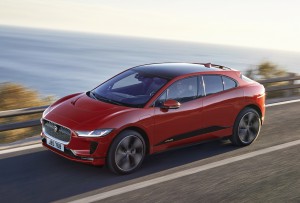
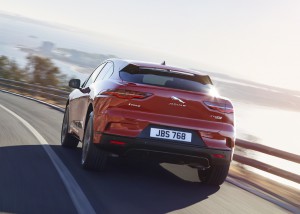
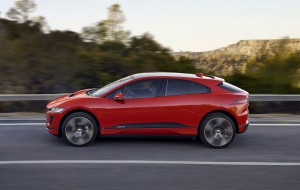
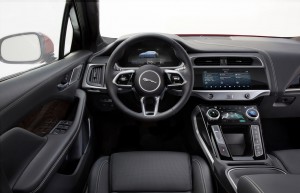
Amazing what Jag is able to do under Tata.